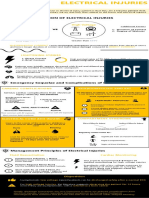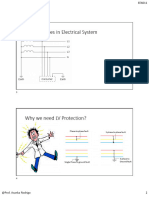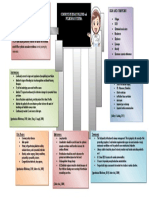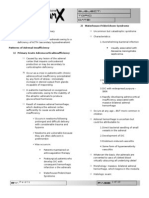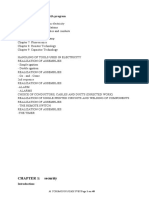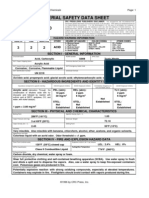Electrical Injuries
Electrical Injuries
Uploaded by
Ikhwan SalamCopyright:
Available Formats
Electrical Injuries
Electrical Injuries
Uploaded by
Ikhwan SalamOriginal Title
Copyright
Available Formats
Share this document
Did you find this document useful?
Is this content inappropriate?
Copyright:
Available Formats
Electrical Injuries
Electrical Injuries
Uploaded by
Ikhwan SalamCopyright:
Available Formats
ELECTRICAL INJURIES
Copyright © 2019 EM Cases
Designed by: Sparsh Shah
Remember that with any burn or electrical injury patient is that they are a trauma patient first.
Follow your primary and secondary survey and only then attend to the burns and electrical injuries
RISK STRATIFICATION OF ELECTRICAL INJURIES
Low Voltage High Voltage
Additional Factors
Copyright © 2019 EM Cases
Designed by: Sparsh Shah
vs 1. Duration of Contact
2. Degree of Wetness
Less than 600V Greater than 600V
ALETERNATING CURRENT causes prolonged contraction preventing full release from electrical source
and hence longer duration of contact and more tissue damage compared to DIRECT CURRENT
LIGHTENING STRIKES
1. Direct Current High survival rates of 70-90%, but up 80% of survivors
2. Brief Contact sustain long-term morbidity
Patients may initially appear deceased with fixed and dilated pupils (autonomic dysfunction)
and cold mottled extremities from vasospasm
Asystole occurs from direct depolarization of the myocardium but typically spontaneous
ROSC is achieved
Respiratory arrest from medullary paralysis can take longer to resolve and patients may
develop a secondary hypoxic arrest.
Emergency Sequelae and Complications of Electrical Injuries
CARDIAC COMPLICATIONS RHABDOMYOLISIS AND AKI
Serious cardiac complications from electrical CK elevation correlates to the extent of muscle injury, but
is not directly related to the probability of developing AKI
injury relatively uncommon
Urine myoglobin has poor sensitivity
Bundle Branch Blocks
AV Blocks
QT prolongation Common, Non-Fatal,
Self Resolving TREATMENT PRINCIPLES
ST changes
Atrial Fibrillation
Correction of volume depletion until the plasma CK
1
level is stable
FATAL ARRYTHMIAS
Forced alkaline diuresis, using sodium bicarbonate
2
to prevent intratubular cast formation
Ventricular Fibrillation Asystole
Consider mannitol or furosemide in the
More common with AC exposures More common with DC exposures 3 presence of obvious myoglobinuria after fluid
resuscitation to prevent acute tubular necrosis
Most common fatal arrythmia and renal failure
ELECTRICAL CORD BITE INJURY COMPARTMENT SYNDROME
Injury to the corner of the mouth in children is Direct Muscle Injury Indirect Muscle Injury
not uncommon after chewing on an electrical
cord
Burns Bleeding
Compartment Syndrome
Regularly assess limbs for:
Look for any tongue and palate burns. Delayed Significant Pain on Passive Extension
massive bleeding from the labial artery can
present 5 – 14 days when the eschar
Rigid Compartments
separates
Signs of Poor Perfusion
Management Principles of Electrical Injuries
Fluid Resuscitation Cardiac Monitoring
Continuous Infusion > Bolus
1 Minimizes tissue edema that could worsen
Our experts recommend 6-8 hours of
tissue damage
cardiac monitoring for high voltage injuries
Patient Require More Fluid In patients with a low voltage exposure in
2 Use the modified Brooke/Parkland Formula
the absence of chest pain or syncope, the
literature does not support need for
Start with RL at 300-500mL/hr cardiac monitoring
3 Then titrate to a urine output >100cc/hr and
other signs of adequate organ perfusion
Disposition
Asymptomatic low voltage injured patients can be discharged safely after a normal ECG
For high voltage injuries, the literature suggests observing the patient for 12 hours
even if they are asymptomatic, with a referral to a burn center
Finally. discharge instructions are very important as there are delayed complications from
electrical injuries. Counsel regarding delayed symptoms including psychological,
neurological, limb ischemia and for kids who bite on an electrical cable, delayed bleeding
You might also like
- Plane Crash Scenario AnswersDocument2 pagesPlane Crash Scenario AnswersAnthony AndersonNo ratings yet
- H's and T's of ACLSDocument1 pageH's and T's of ACLSgabbyneng100% (1)
- Buergers Disease NCPDocument5 pagesBuergers Disease NCPNikko Dela Cruz100% (2)
- Web-Sling-Recommended-Operating-and-Inspection-GuidelineDocument12 pagesWeb-Sling-Recommended-Operating-and-Inspection-Guidelineibrahim100% (1)
- Electrical InjuriesDocument1 pageElectrical InjuriesnancyNo ratings yet
- Early Management: Admit To Burns UnitDocument1 pageEarly Management: Admit To Burns UnitErica A. Gallegos AriasNo ratings yet
- Electrical InjuriesDocument5 pagesElectrical InjuriesFalon PapalangiNo ratings yet
- ElectricDocument3 pagesElectricJalal AwanNo ratings yet
- Power SystemsDocument11 pagesPower SystemssrnwsdbNo ratings yet
- Chapter 15Document13 pagesChapter 15Adrián Jacobo Ávila SánchezNo ratings yet
- ECG ErrorsDocument5 pagesECG ErrorsmikeNo ratings yet
- 09 2018 Biomedical Instrumentation - SafetyDocument37 pages09 2018 Biomedical Instrumentation - Safetyviki mikiNo ratings yet
- 18 - First Aid in Electrical InjuriesDocument39 pages18 - First Aid in Electrical InjuriesIsael sierraNo ratings yet
- Electric Shock: Electric Current Voltage ResistanceDocument23 pagesElectric Shock: Electric Current Voltage ResistanceraniaworkNo ratings yet
- Modified Galvanic CurrentDocument26 pagesModified Galvanic CurrentfourtechmediadmeagentsNo ratings yet
- Risk Electric: Jerson Rodrigo Rojas Gamez, Victor Rodríguez Cod.45141025Document4 pagesRisk Electric: Jerson Rodrigo Rojas Gamez, Victor Rodríguez Cod.45141025Victor RodriguezNo ratings yet
- Animal Toxicology Lecture 10Document21 pagesAnimal Toxicology Lecture 10Incha MaayaloNo ratings yet
- Dawes 2006Document4 pagesDawes 2006bert.sutterNo ratings yet
- Mindmap ELECTRICAL INJURY ZimlyDocument1 pageMindmap ELECTRICAL INJURY ZimlyWahyu adi PratamaNo ratings yet
- 470 895 1 SMDocument37 pages470 895 1 SMfadhlurrahmanNo ratings yet
- Electrocution and Electrical Injuries: Basic Concepts and PathophysiologyDocument7 pagesElectrocution and Electrical Injuries: Basic Concepts and PathophysiologyYosuaNo ratings yet
- Congestive Heart Failure and Pulmonary Edema: Nursing Diagnoses InterventionsDocument1 pageCongestive Heart Failure and Pulmonary Edema: Nursing Diagnoses InterventionsLovely CacapitNo ratings yet
- Decreased Cardiac Output Ready To PrintDocument3 pagesDecreased Cardiac Output Ready To PrintAnne SedanzaNo ratings yet
- HEMA 2 - Midterm Topic 3 - Anemia of Bone Marrow DisorderDocument10 pagesHEMA 2 - Midterm Topic 3 - Anemia of Bone Marrow DisorderLowenstein JenzenNo ratings yet
- 8 Patient SafetyDocument13 pages8 Patient SafetyXyr crxNo ratings yet
- Seminar On Industrial Power System Design and Practices-Fault CalculationsDocument45 pagesSeminar On Industrial Power System Design and Practices-Fault CalculationsIsagani MadridNo ratings yet
- Worksheet 4 - Factors Influencing The Effect of Electric Current - SolutionDocument2 pagesWorksheet 4 - Factors Influencing The Effect of Electric Current - SolutionALEIX PUIG MAHIQUESNo ratings yet
- 10 Acute Biologic CrisisDocument11 pages10 Acute Biologic CrisisJanely EstreraNo ratings yet
- Electrical BurnsDocument28 pagesElectrical BurnsFrancis OkwerekwuNo ratings yet
- ANESKEY-Lightning and Electrical InjuriesDocument7 pagesANESKEY-Lightning and Electrical InjuriesJOSE LUIS FALCON CHAVEZNo ratings yet
- Electrical Shocks and BurnsDocument39 pagesElectrical Shocks and BurnsMr.BiplobNo ratings yet
- Ards PDFDocument20 pagesArds PDFRuki HartawanNo ratings yet
- Jurnal Luka SetrumDocument4 pagesJurnal Luka Setrumuchii02No ratings yet
- Electrical BurnsDocument26 pagesElectrical Burnsraja020No ratings yet
- B25217 Electrical Safety EngDocument22 pagesB25217 Electrical Safety Engyourxmen2910No ratings yet
- Biomedical Instrumentation: Safety of Electrical Medical DevicesDocument32 pagesBiomedical Instrumentation: Safety of Electrical Medical DevicesSavikhyaNo ratings yet
- Ahead of Print Issue-Article 201408-19 PDFDocument26 pagesAhead of Print Issue-Article 201408-19 PDFSyilla PriscilliaNo ratings yet
- ABB - RCD Technical Guide en 1-39Document39 pagesABB - RCD Technical Guide en 1-39stef_touloglouNo ratings yet
- RCD Technical Guide ENDocument80 pagesRCD Technical Guide ENahmed abdellahNo ratings yet
- Fluke Electrical SafetyDocument5 pagesFluke Electrical SafetyDiophantus MabutinNo ratings yet
- g11 Module Electrical SafetyDocument13 pagesg11 Module Electrical SafetyHarold Vernon MartinezNo ratings yet
- Melphalan PDFDocument1 pageMelphalan PDFZeny ArtilleraNo ratings yet
- Electro FishingDocument2 pagesElectro FishingSujit ShandilyaNo ratings yet
- 01 Cir 27 1 5Document7 pages01 Cir 27 1 5YabesNo ratings yet
- Endocrine System - Part 3 (Robbins)Document10 pagesEndocrine System - Part 3 (Robbins)sarguss14No ratings yet
- 1 s2.0 S1472029919302917 MainDocument7 pages1 s2.0 S1472029919302917 MainEliana Lopez BaronNo ratings yet
- Electrical Shock PDFDocument3 pagesElectrical Shock PDFPeterNo ratings yet
- ElectrosurgeryDocument14 pagesElectrosurgerynishanth vemanaNo ratings yet
- Electrical Wire Burn, For Which Children Must Be Admitted ForDocument7 pagesElectrical Wire Burn, For Which Children Must Be Admitted Forraja020No ratings yet
- TECHNOLOGIE-SCHEMA-Seconde-F23 Tchomguy - Fr.enDocument40 pagesTECHNOLOGIE-SCHEMA-Seconde-F23 Tchomguy - Fr.eneugeni madaNo ratings yet
- Electrical Injury: By: Mohd Khairul Izzati OmarDocument28 pagesElectrical Injury: By: Mohd Khairul Izzati OmarInsyirah QalbiNo ratings yet
- Chapter 35 Early Effects of RadiationDocument6 pagesChapter 35 Early Effects of RadiationEarl RemorozaNo ratings yet
- Cardiology Medsurg LectureDocument9 pagesCardiology Medsurg LectureTine GuibaoNo ratings yet
- Pbcatpg21 22Document2 pagesPbcatpg21 22JosipJosipNo ratings yet
- Electrical SafetyDocument20 pagesElectrical SafetyMohamed MamdouhNo ratings yet
- Incessant VT VFDocument9 pagesIncessant VT VFTor JaNo ratings yet
- OsteoarthritisDocument31 pagesOsteoarthritisVinoth RocksonNo ratings yet
- Mod 2 Comp 13 - Demonstrate Knowledge of Electrical Safety and Safe Working Practices For Electrical WorkersDocument9 pagesMod 2 Comp 13 - Demonstrate Knowledge of Electrical Safety and Safe Working Practices For Electrical WorkersSmr OnlyNo ratings yet
- Management of Patients With Electrical Storm: An Educational ReviewDocument5 pagesManagement of Patients With Electrical Storm: An Educational ReviewurielNo ratings yet
- Vasculitis by VinhDocument4 pagesVasculitis by VinhTovin NguyenNo ratings yet
- Acute Management of Hand BurnsDocument8 pagesAcute Management of Hand BurnsMaria NoratoNo ratings yet
- Summary C19-20Document15 pagesSummary C19-20EleanorNo ratings yet
- MTA Aranda - Manuaali 14012015 - Full VersionDocument50 pagesMTA Aranda - Manuaali 14012015 - Full VersionJose CasasNo ratings yet
- N HexaneDocument6 pagesN HexaneAde HadyNo ratings yet
- WATLUBE - Material Safety Data SheetDocument2 pagesWATLUBE - Material Safety Data SheetJohn Jairo CelisNo ratings yet
- OEC ch25Document10 pagesOEC ch25Phil McLeanNo ratings yet
- Msds PDFDocument6 pagesMsds PDFEncepMuhammadIlyasNo ratings yet
- Biomonitoring of 5 Flourouracil - AnyDocument23 pagesBiomonitoring of 5 Flourouracil - AnyAgus TianyNo ratings yet
- Bosh Incident ReportDocument5 pagesBosh Incident ReportjabamiNo ratings yet
- Piosh Chapter 3Document4 pagesPiosh Chapter 3Rasyiqah AlyaaNo ratings yet
- Requirements For Human LifeDocument5 pagesRequirements For Human LifeJayrelle D. SafranNo ratings yet
- Acrylic Acid MSDSDocument6 pagesAcrylic Acid MSDSpradeepmenon1982100% (1)
- Vital Signs Chap 7Document103 pagesVital Signs Chap 7Fahad MahmoodNo ratings yet
- Denner - A PRIMER ON CLOTHING SYSTEMS FOR COLD-WEATHER FIELD WORK - 1993Document21 pagesDenner - A PRIMER ON CLOTHING SYSTEMS FOR COLD-WEATHER FIELD WORK - 1993neoNo ratings yet
- Management Guideline NICU Updated 2018 - PediMedicineDocument213 pagesManagement Guideline NICU Updated 2018 - PediMedicinenishan chakma100% (1)
- Heat Tolerance Test PDFDocument7 pagesHeat Tolerance Test PDFMonica LapusNo ratings yet
- NCP No. 2Document2 pagesNCP No. 2Lorraine Tuesday BuenviajeNo ratings yet
- The Hall Pneumatic Handpieces Instruction Manual: PowerproDocument32 pagesThe Hall Pneumatic Handpieces Instruction Manual: PowerproAndres CamachoNo ratings yet
- Artic Sun 5000Document16 pagesArtic Sun 5000AndrésNo ratings yet
- First AidDocument9 pagesFirst AidJm BernardoNo ratings yet
- Material Safety Data Sheet Tapmatic Dual Action Plus #1 Cutting FluidDocument10 pagesMaterial Safety Data Sheet Tapmatic Dual Action Plus #1 Cutting FluidKarl MakoyNo ratings yet
- Pe 11Document2 pagesPe 11rheyNo ratings yet
- MSDS T-ButhylDocument7 pagesMSDS T-ButhylArfin FardiansyahNo ratings yet
- Risk Register Skiing Snowboarding Year 10 ODEDocument6 pagesRisk Register Skiing Snowboarding Year 10 ODELachlan WRIGHTNo ratings yet
- Case Study Burn InjuryDocument9 pagesCase Study Burn InjuryDoneva Lyn MedinaNo ratings yet
- Traditional Chinese Medicine EPI Cough Sinusitis NotesDocument8 pagesTraditional Chinese Medicine EPI Cough Sinusitis NotesJanelleNo ratings yet
- Soal 21Document4 pagesSoal 21obhetzNo ratings yet
- Emergency and Disaster Care NotesDocument11 pagesEmergency and Disaster Care NotesCharm TanyaNo ratings yet
- MSDS-MDT Plus 4 2017Document2 pagesMSDS-MDT Plus 4 2017Ade IrawanNo ratings yet




